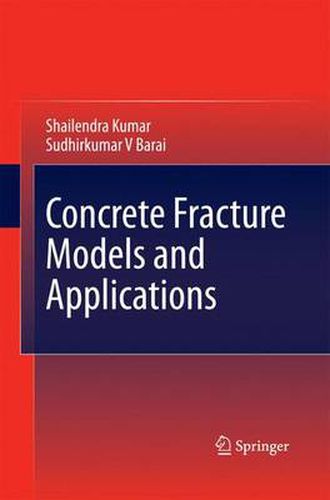Readings Newsletter
Become a Readings Member to make your shopping experience even easier.
Sign in or sign up for free!
You’re not far away from qualifying for FREE standard shipping within Australia
You’ve qualified for FREE standard shipping within Australia
The cart is loading…






This title is printed to order. This book may have been self-published. If so, we cannot guarantee the quality of the content. In the main most books will have gone through the editing process however some may not. We therefore suggest that you be aware of this before ordering this book. If in doubt check either the author or publisher’s details as we are unable to accept any returns unless they are faulty. Please contact us if you have any questions.
Cementitious materials, rocks and fibre-reinforced composites commonly termed as quasibrittle, need a different fracture mechanics approach to model the crack propagation study because of the presence of significant size of fracture process zone ahead of the crack-tip. Recent studies show that concrete structures manifest three important stages in fracture process: crack initiation, stable crack propagation and unstable fracture or failure. Fracture Mechanics concept can better explain the above various stages including the concepts of ductility, size-effect, strain softening and post-cracking behavior of concrete and concrete structures.
The book presents a basic introduction on the various nonlinear concrete fracture models considering the respective fracture parameters. To this end, a thorough state-of-the-art review on various aspects of the material behavior and development of different concrete fracture models is presented. The development of cohesive crack model for standard test geometries using commonly used softening functions is shown and extensive studies on the behavior of cohesive crack fracture parameters are also carried out. The subsequent chapter contains the extensive study on the double-K and double-G fracture parameters in which some recent developments on the related fracture parameters are illustrated including introduction of weight function method to Double-K Fracture Model and formulization of size-effect behavior of the double-K fracture parameters. The application of weight function approach for determining of the KR-curve associated with cohesive stress distribution in the fracture process zone is also presented. Available test data are used to validate the new approach. Further, effect of specimen geometry, loading condition, size-effect and softening function on various fracture parameters is investigated. Towards the end, a comparative study between different fracture parameters obtained from various models is presented.
$9.00 standard shipping within Australia
FREE standard shipping within Australia for orders over $100.00
Express & International shipping calculated at checkout
This title is printed to order. This book may have been self-published. If so, we cannot guarantee the quality of the content. In the main most books will have gone through the editing process however some may not. We therefore suggest that you be aware of this before ordering this book. If in doubt check either the author or publisher’s details as we are unable to accept any returns unless they are faulty. Please contact us if you have any questions.
Cementitious materials, rocks and fibre-reinforced composites commonly termed as quasibrittle, need a different fracture mechanics approach to model the crack propagation study because of the presence of significant size of fracture process zone ahead of the crack-tip. Recent studies show that concrete structures manifest three important stages in fracture process: crack initiation, stable crack propagation and unstable fracture or failure. Fracture Mechanics concept can better explain the above various stages including the concepts of ductility, size-effect, strain softening and post-cracking behavior of concrete and concrete structures.
The book presents a basic introduction on the various nonlinear concrete fracture models considering the respective fracture parameters. To this end, a thorough state-of-the-art review on various aspects of the material behavior and development of different concrete fracture models is presented. The development of cohesive crack model for standard test geometries using commonly used softening functions is shown and extensive studies on the behavior of cohesive crack fracture parameters are also carried out. The subsequent chapter contains the extensive study on the double-K and double-G fracture parameters in which some recent developments on the related fracture parameters are illustrated including introduction of weight function method to Double-K Fracture Model and formulization of size-effect behavior of the double-K fracture parameters. The application of weight function approach for determining of the KR-curve associated with cohesive stress distribution in the fracture process zone is also presented. Available test data are used to validate the new approach. Further, effect of specimen geometry, loading condition, size-effect and softening function on various fracture parameters is investigated. Towards the end, a comparative study between different fracture parameters obtained from various models is presented.